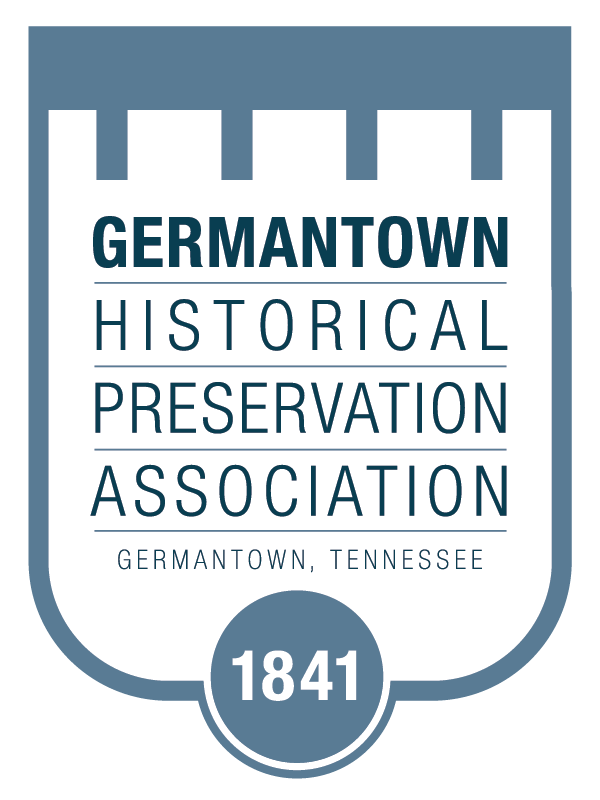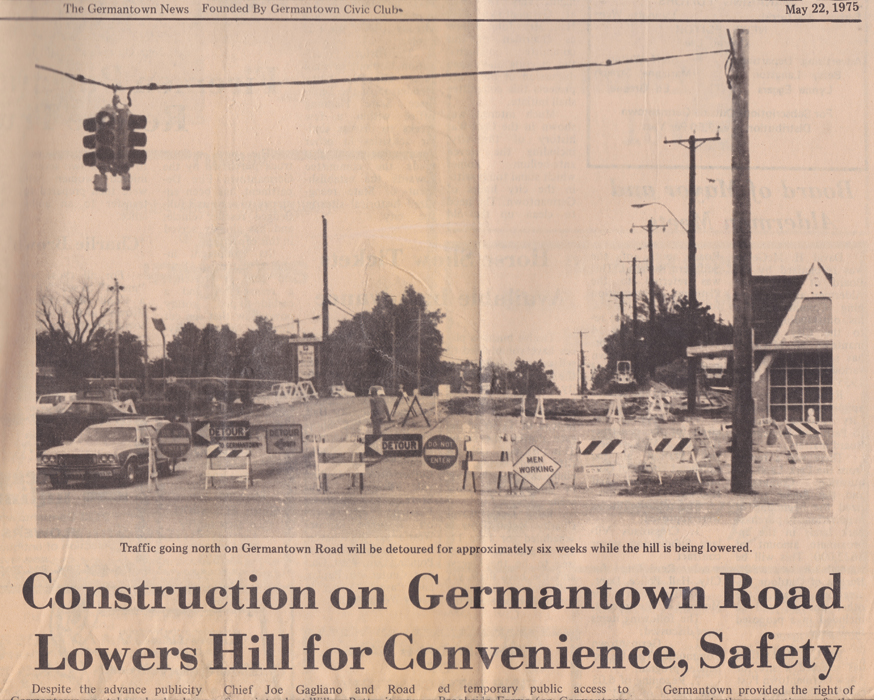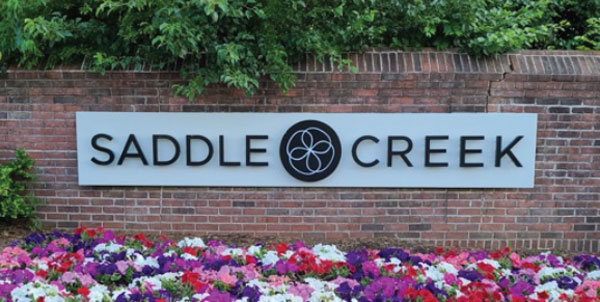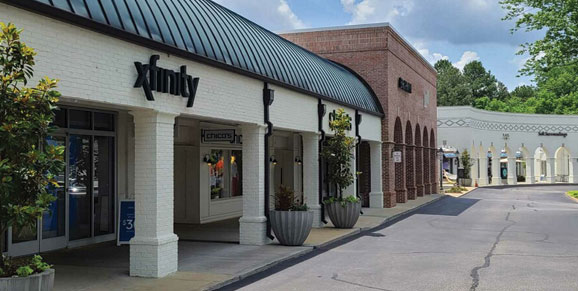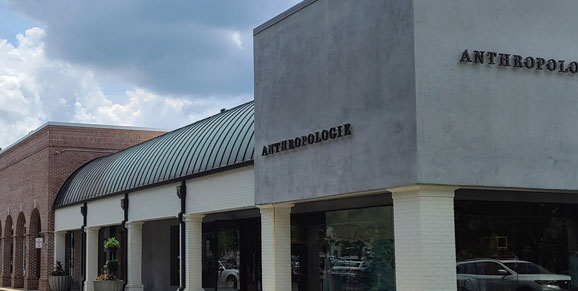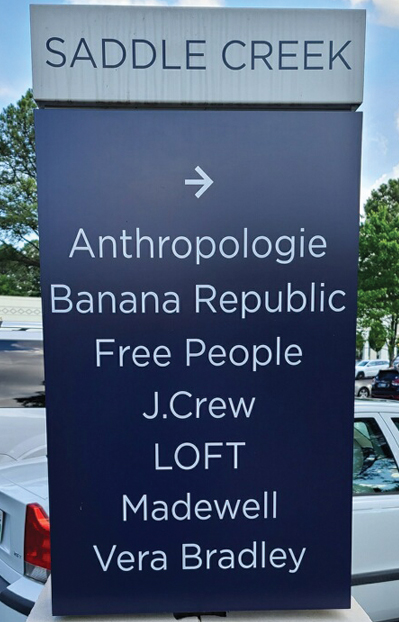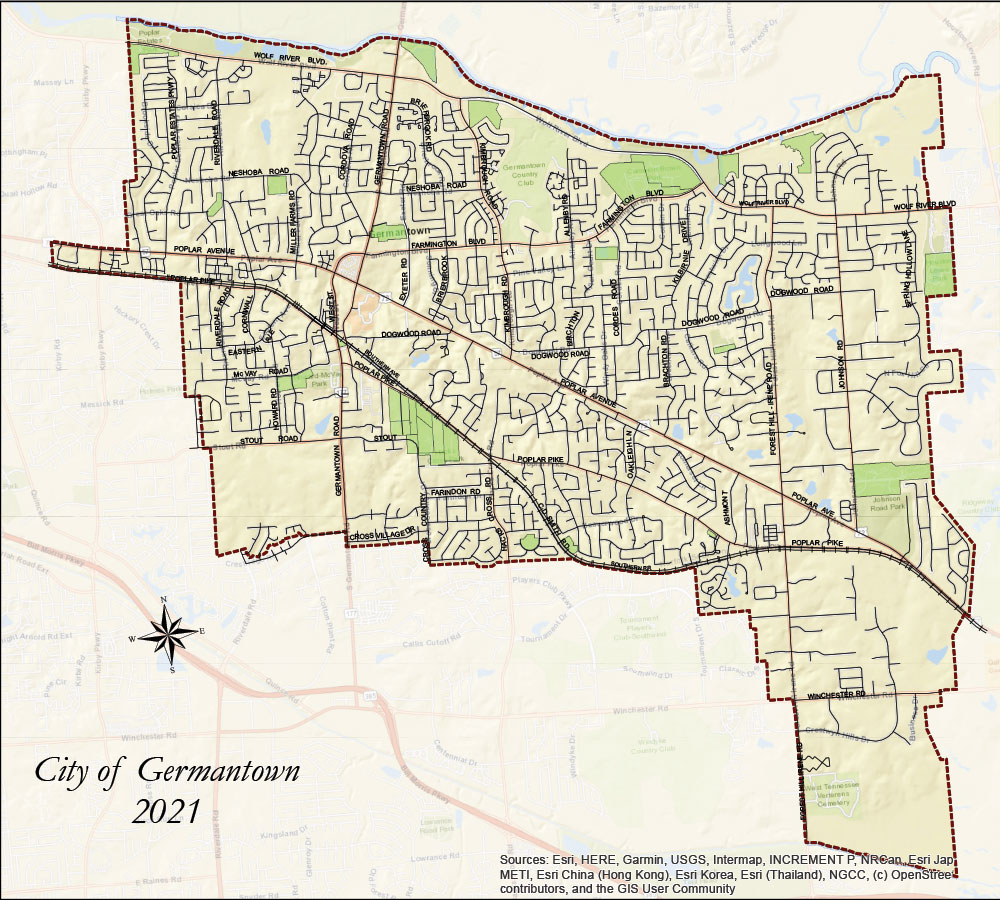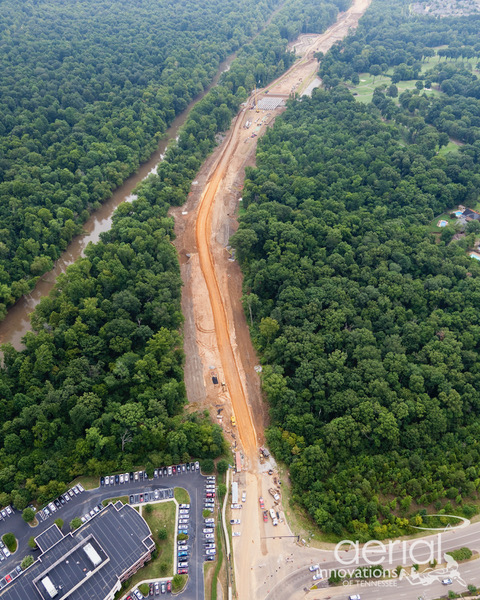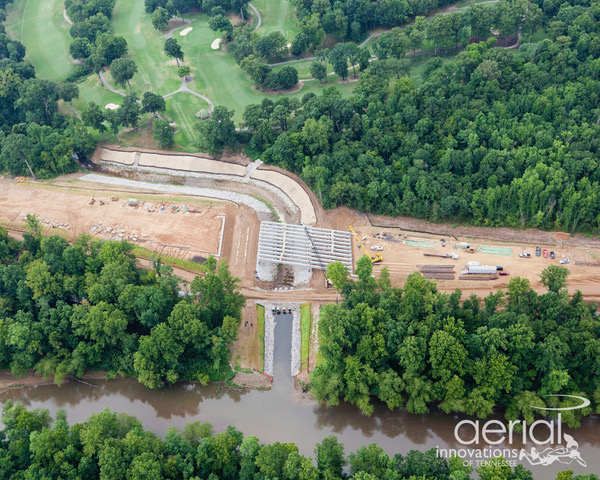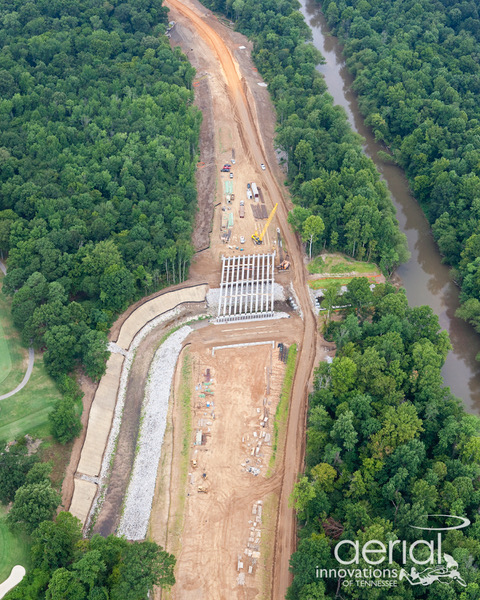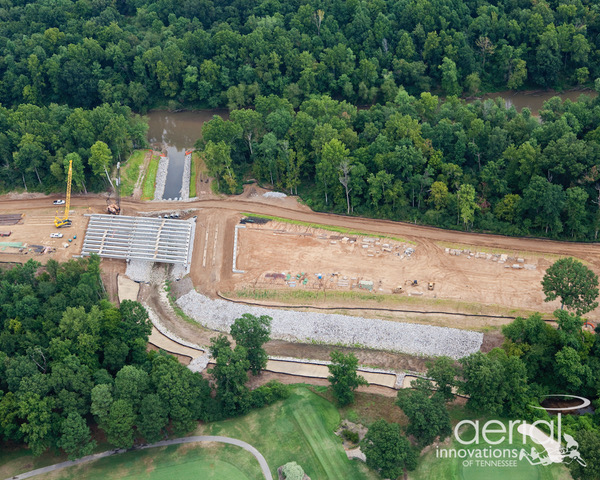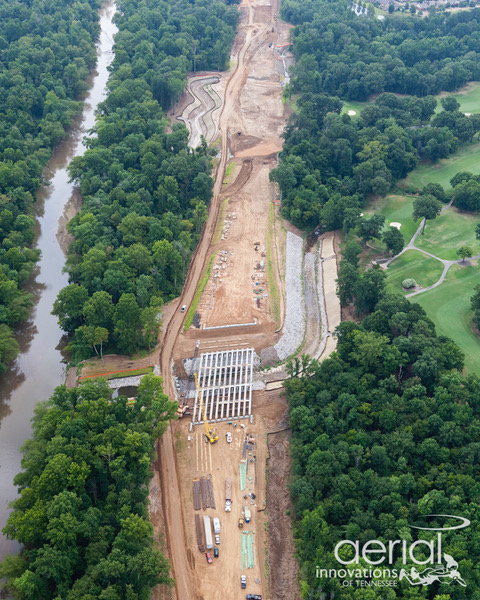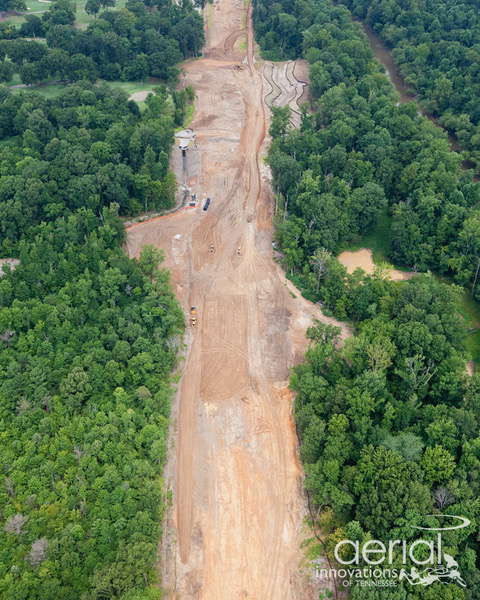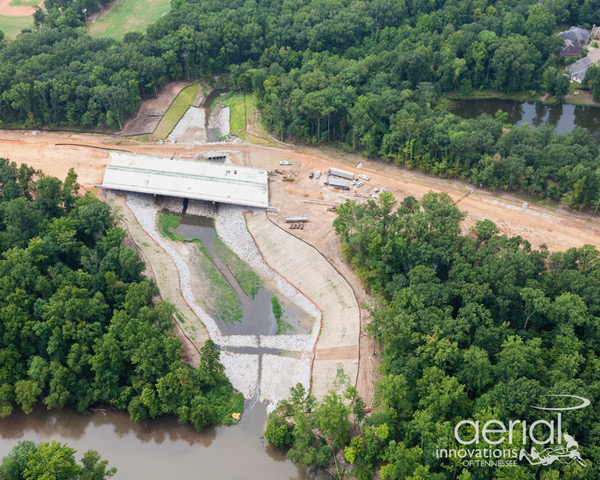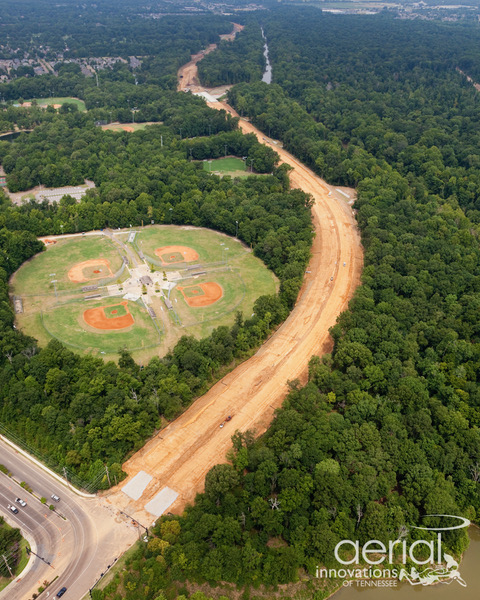
Development History
- City’s beginnings traced to settlement established on a flood-protected roadway
- Construction on Germantown Road Lowers Hill for Convenience, Safety
- Saddle Creek “Lifestyle Center”
- Smart Growth
- Construction of Wolf River Boulevard Extended (Kimbrough to Farmington)
City’s beginnings traced to settlement established on a flood-protected roadway
By Perre Magness (Advertising Supplement to the Commercial Appeal, Sunday, October 29, 1995
with additions by Andrew Pouncey, August 21, 2018
The roads of Shelby County are older than the towns. First buffalo, then deer and other animals, beat trails through the woods along the high ground that never flooded.
Next Indians, and finally settlers, followed the routes through the forests, keeping to the high ground when wet weather made the low-lying areas impassable. One such trail became Poplar Pike, which follows a ridge through the county, with one exception, the creeks on the north side empty into the Wolf River and the creeks on the south drain into Nonconnah. Today, these creeks are called laterals.
In 1825, William Twyford and his wife settled on that ridge, in the middle of the county, in the area known today as Germantown. His neighbor Frances Wright established her utopian community the same year; and Thomas L. Moody and a merchant named Rash soon followed. By 1830, there were enough people to form a settlement called Pea Ridge along the trail. A post office opened on July 11, 1833. A log schoolhouse was built, and various denominations used it for meetings whenever a wandering preacher appeared. The first polling place was at the home of Colonel Eppy White (known later as Kirby Farms).
In 1834, a landowner named Colonel G. P. Shepherd decided to survey his land and divide it into lots. It was the first of many subdivisions.
By 1836, the settlement was known as Germantown. There are several theories as to the name: A man named N.T. German surveyed the land for Shepherd; two Germans named Lucken and Schieley were among the first settlers; Frederich Lucken (or Luchen) of Bremen, Germany was the first innkeeper and the first postmaster.
On March 24, 1836, the Presbyterians organized a church with the Reverend A.G. McNutt as a pastor and seven charter members. Worship services were held in members’ homes and the schoolhouse. In 1851, the Presbyterians built a frame church. The church was dedicated on May 14-15, 1853, and is still in use as a chapel for Germantown Presbyterian Church, making it the only pre-Civil War public building still standing in Germantown. The Reverend Richard R. Evans served as minister from 1850 until his death in 1903 at the age of eighty-five. In 1950, the building was turned to face east, and a portico was added.
Pea Ridge Baptist Church was organized in 1833, and New Hope Baptist Church was organized around 1935. By 1838, they had combined to form one congregation. In the early years, they shared meeting space with the Presbyterians and the Methodists. Early Baptist records, with the exception of their Bible, were destroyed by fire; but in 1841, Wilkes Brooks donated land for a church building on Bridge Street (now Germantown Road). By 1846, the Baptists had 98 white and 34 black members.
The frame building belonging to the Baptists was used for firewood by Union Troops during the Civil War. Post Civil War, the congregation sued the United States government for damages and received a settlement. By 1870, the congregation was strong enough to erect another frame building that served them for one hundred years (restored in two phases – January 2015 and September 2016), and finally as a chapel after a new modern building was built.
On December 9, 1840, the Methodists purchased a lot on Church Street (now McVay Road) from George and Nicey Shepherd, where, when the congregation numbered about 45, they built a frame church and a graveyard (McVay Gardens Cemetery). The church was badly damaged in the Civil War, and a new building was erected about 1870.
A Masonic Lodge was organized in 1841, and the town was incorporated on December 28, 1841.
The first plank toll road in Shelby County was built from Memphis to Holly Springs in 1849. Mail coaches and stagecoaches followed the route through Germantown. In 1852, the Memphis and Charleston Railroad was built. Travelers could switch from horse-drawn coach to the railroad at Germantown. Goodspeed’s History of Hamilton, Knox, and Shelby Counties, published in 1887, says “This village, being near the line of the old Memphis and LaGrange Railroad, was a place of great commercial activity from 1840 to 1850, and even sometime later. Cotton and the usual farm products are handled extensively at Germantown.”
By the 1850s, Germantown had a population of 245, three churches, two hotels, a cotton gin, a boys’ school, a girls’ school, and the Germantown Classical and Military Institute. According to a railroad guidebook, there were three resorts in evergreen groves: Nashoba, White Sulphur Springs, and Brunswick Springs. The guidebook went on to say about Germantown, “The inhabitants are generally moral, intelligent, and a reading people.”
The Civil War did more physical damage to Germantown than it did to Memphis. In 1861, the Fourth Tennessee Regiment of the Confederate Army assembled in Germantown with 962 men in companies from Shelby, Tipton, Lauderdale, Dyer, Obion, Hardeman, and Gibson counties. The next year, Confederate troops caused a federal supply train to derail and fought a skirmish with the 56th Ohio infantry.
Following victories in Shiloh and Corinth, the Union Army occupied Germantown in 1862 and camped to the south and east of the town. An earthworks fort (now known as Fort Germantown) was built along the railroad track. Public buildings were burned; the story goes that only the Masonic Hall and Presbyterian Church were saved, because the Union commander and the Presbyterian preacher, Richard R. Evans, were both Masons and Presbyterians. The church was used as a stable and the Masonic Hall as a hospital.
While the Presbyterians were building their church, the Baptists had allowed them to use their sanctuary. Upon completion, the Presbyterians a resolution thanking the Baptists, “for the privilege of worshipping God in their sanctuary.” and offered to return the favor if the Baptists ever needed it. When the Union Army burned the Baptist Church, the Presbyterians were able to return the favor.
Germantown’s population declined after the Civil War. In 1870, there were only 197 residents. The town was rechartered in 1871. During the yellow fever epidemics of the 1870s, many Memphians came to Germantown, thinking they would be safe from the contagion, and the population grew to 400. But in the worst plague year, 1878, about fifty percent of the population of Germantown died or moved away because of the epidemic.
Wilks Brooks and his son Joseph arrived in Shelby County from North Carolina in 1834 and moved to Woodlawn Plantation near Germantown in 1836. His son Joseph opened a store nearby. Tradition has it that when federal troops were camped nearby, Mrs. Brooks was often asked to play the piano for the wounded soldiers. The Woodlawn plantation house was moved to a residential street (Old Oak Drive – Memphis) that was part of the original property; it is the earliest example of Greek Revival architecture in Shelby County.
The first public school classes were held in the first floor of the Masonic Hall. In 1887, there were about 100 pupils. The Mabel C. Williams School was completed in 1911 to house grades 1 through 12.
In 1900, the Southern Railway, which had absorbed the Memphis and Charleston, had trains that made 16 stops between Germantown and Memphis.
During World War 1, feeling against the Germans ran so high that a group of 326 residents petitioned that the name of the town be changed from Germantown to “Woodrow”, honoring President Woodrow Wilson. It was reported that 23 Germantown boys were in the service, and most of them had written home asking that the name Germantown be left off their letters because it prompted their comrades to scoff. Instead of Woodrow, the town changed its name to Neshoba, for the early Utopian community on the plantation of Frances Wright, now spelling Neshoba with an “e” instead of an “a.” The name change lasted only a short while; on April 4, 1922, the town became Germantown again.
By 1972, the population was 5,000. Then the boom was on. By 1976, the population had more than doubled to 12,900 and four years later it had grown to 21,482. New subdivisions, schools, shopping centers, hospitals, and churches filled the cotton fields. By 2007 and with a population of 40,123, the City recognized that its borders were permanently established, and began adopting new development policies to protect its future fiscal viability within this predominantly residential community.
Construction on Germantown Road Lowers Hill for Convenience, Safety
The Germantown News founded by the Germantown Civic Club on May 22, 1975
Despite the advance publicity, Germantown was taken aback when the construction really began on Germantown Road, north of Highway 72 last week. Questions of what’s going on and how long will it last filled the air from drivers and businesspeople in the area.
The answer is that the hill on Germantown Road is being lowered to provide better access to businesses and to improve safety. Even with the tremendous backlog of road work the Shelby County Road Department planned for the construction season, this much-needed project was given top priority by Lee Hyden, County Commissioner of Roads, Bridges, and Penal Farm, in order to help the city of Germantown.
To minimize the inconvenience caused by the construction, Shelby County anticipates having the project completed in six weeks, weather permitting, according to William Hays, Commissioner Hyden’s Executive assistant. However, over the last one and one-half, year period weather has immensely hampered the operation of public works.
Right now, the east or northbound lane of traffic on Germantown Road is being cut down. The deepest cut in grade will be seven feet. After the grade is taken down, the lane will be graveled so that traffic can flow on it while the same process is completed on the west or southbound lane.
Originally it was hoped that two-way traffic could be permitted during the construction period. After county traffic engineer, Nick Ferro discussed the situation with Germantown Police Chief Joe Gagliano and Road Superintendent Wilbur Betty, it was decided that it was too dangerous to permit two-way traffic because of the narrow roadway. Cars would be too close to opposing traffic and to the construction equipment. Also, there is the danger of the difference in grade elevation.
“In the interest of traffic safety, it was decided to put the detour in effect,” added Mr. Hays. “At the same time, we have provided temporary public access to Brookside Farms (on Germantown Road) from Poplar Avenue.” This business operation was being affected by the detour.
The detour will remain until both lanes are cut down and graveled. The paving will follow as soon as the stabilization is completed.
“At an approximate cost of $75,000,” County Engineer George Dando said, “the construction is proceeding as planned. The city of Germantown provided the right of way and the relocation of the utilities; First National Bank contributed $11,000 to the project; and Shelby County assumes all of the labor, equipment, and material costs.”
As construction continues, the Germantown Police Department is keeping a constant watch on traffic conditions at the corner. They are also concerned that motorists follow the detour routing.
Saddle Creek “Lifestyle Center”
The Society of Entrepreneurs wrote, “occasionally an idea comes along that changes America’s lifestyle. In the mid-1980s, native Memphian Dan Poag had such an idea. He and a previous partner had the vision to create a concept in shopping centers by combining top specialty stores and restaurants in an architecturally upscale, open-air setting that was convenient and safe for the customer.”
First labeled “Lifestyle Centers” by Memphis developers Poag and McEwen in the late 1980s, they emerged as a retailing trend in the late 1990s. The idea culminated in what is now The Shops of Saddle Creek in Germantown, on West Street between Poplar and Germantown Roads. Opened in 1987, it would be recognized as the first “Lifestyle Center” developed in the country. Years later, Poag would develop Saddle Creek South, on the southwest corner of Poplar and West Street, also in Germantown.
Poag & McEwen would be widely recognized as the “Father of Lifestyle Centers” and establish their concept nationally by being the leading developer of Lifestyle Centers in the United States, including Omaha, Kansas City, Chicago, Denver, Colorado Springs, Loveland (CO), Hartford, Lehigh Valley (PA), Manteca (CA), and Los Angeles.
Poag says “entrepreneurship starts with the idea; however, there are many great ideas. Passionate belief in the idea contrary to all “good” advice and opinion that your idea will not work, coupled with an absolute determination to succeed no matter what the obstacles are in my opinion, is the key to building the foundation of entrepreneurship. The complete building makes the community where it is located a better place to live and improves everyone’s lifestyle.”
In 2018, Dan’s son Josh, President and Chief Executive Officer at Poag Shopping Centers, wrote, “it was more than 30 years ago when my father noticed that my mother wasn’t enjoying family trips to the mall, and he decided to do something about it: design and deliver the kind of retail destination that people wouldn’t see as a chore, but as something engaging and enjoyable. There would be a mix of national specialty retailers and restaurants plus amenities and aesthetic details. Thus, was born the lifestyle center. My father, Dan Poag, was responsible for coining and trademarking the term “Lifestyle Center.” He started Poag & McEwen to develop them and three decades later its successor, Poag Shopping Centers, remains on the forefront of lifestyle center innovation.”
The proliferation of lifestyle centers in the United States accelerated in the 2000s, growing in number from 30 in 2002 to 130 at the end of 2004. They typically require less land and may generate higher revenue margins, generating close to $500 per square foot, compared \to an average of $300 per square foot for a traditional mall according to Poag. Other advantages lifestyle centers have over traditional enclosed malls are savings on heating and cooling and quicker access for customers.2
For further information see https:///www.poagllc.com and Apr 7, 2017, Memphis Business Journal article by Jacob Steimer – “Pinnacle Awards: Poag created a new way of ‘life’ in Hall of Fame career”
Sources: https://soememphis.com/members/g-dan/en.wikipedia.org/wiki/ – Lifestyle Center
https://chairstoreage.co/real – “How Lifestyle centers have evolved with the times.” By Josh Poag
Smart Growth
By Andrew Pouncey
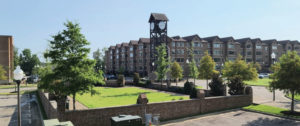
Thornwood in the Central Business District
Beginning in the summer of 2006 and continuing through early 2007, citizens, business and property owners, elected officials, and City staff collaborated with planners and designers from The Lawrence Group, Rose & Associates, Southeast, Inc., Henson-Harrington, Inc., and Kimley-Horn & Associates, Inc. to develop a vision for Germantown, Tennessee’s 700-acre commercial core.
The city commissioned the effort in fulfillment of Goal 7 of the Germantown vision 2020 plan: the Redevelopment of the Heart of Germantown. The Vision 2020 objectives call for mixed-use development, strong commercial services, interspersed with residential uses in a pedestrian-friendly environment that would create “a sense of place” for the community – all characteristics of a national land-use planning and design movement called Smart Growth. The plan was also part of the City’s effort to continue to grow economically in a “smart” and sustainable way. Thus, the plan was aptly called the Smart Growth Plan.
The City’s Board of Mayor and Aldermen appointed a Steering Committee of key staff to oversee the process. The Steering Committee provided guidance and review throughout the process. Rose & Associates completed a market study to identify supply and demand for various types of development in the plan area to recommend appropriate development locations. From September 20-26, the community participated in a seven-day public design workshop called a “charette” to establish the community vision and develop the plan’s primary recommendations.
The plan that resulted from the charrette effort encompassed all of the objectives of Goal 7, including the overarching objective of “creating a sense of place” for Germantown. The plan established a design concept for future land use and redevelopment in the plan area over the next 20 years. The plan also included development concepts for two key, undeveloped pieces at the northern and western edges of the study area. The design scheme sought to create viable mixed-use development, but also to respect the surrounding neighborhoods, provide open space, and create unique mixed-use environments that were not currently available in the Germantown area. Finally, the concept plan proposed a number of smaller-scale infill and redevelopment opportunities in the study area.
Staff next met over 40 times with various groups including the Mayor and Board of Aldermen, various commissions, community shareholders, businesses, and neighbors to answer questions, provide transparency and gather input.
The Smart Growth Plan, the general land use plan for the City’s Central Business District, was approved by a resolution by the Board of Mayor and Aldermen (BMA) in 2007. A special code of ordinances or SmartCode was also adopted and replaced the existing zoning code for the Smart Growth area. The SmartCode governs such items as building setbacks and height, parking requirements, and allowable uses.
To this date, Overlay Zones have been approved for the Central Business District, the Western Gateway, and the Forest Hill Corridor. The other zones are the Medical Corridor and the Forest Hill Corridor.
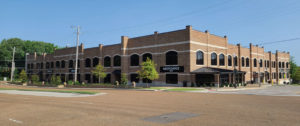
Source: https://www.germantown-tn.gov/home/showpublisheddocument/20757/636568057155570000
Construction of Wolf River Boulevard Extended (Kimbrough to Farmington)
- 1st Photo: View from West to East from intersection of Wolf River Boulevard and Kimbrough Road at beginning of project
- 2nd Photo: View from North to South of western bridge looking toward former Germantown Country Club Golf Course
- 3rd Photo: View from East to West across western bridge toward Kimbrough Road
- 4th Photo: View from South to North across western bridge to Wolf River
- 5th Photo: View from West to East across western bridge
- 6th Photo: View from East to West with Germantown County Club Golf Course in top left corner
- 7th Photo: View from South to North across eastern bridge
- 8th Photo: View from East to West across eastern bridge
- 9th Photo: View from East to West from the intersection of Farmington Blvd. and Wolf River Boulevard at terminus of two (2) mile project
